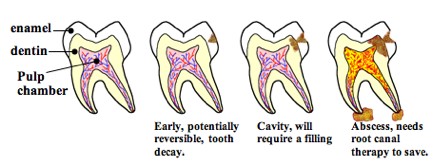
The simple definition. A cavity is a hole in a tooth caused by a bacterial disease commonly referred to as dental decay or tooth decay.
Facts about cavities
•Dental decay is
actually a communicable disease. Most of us acquired the bacteria that cause
decay in our infancy from our parents.
• The plaque that forms on your teeth starts as bacteria cling to the tooth surface. Then the bacteria pile up on each other as they multiply. The continuously growing mound of bacteria also traps food debris and saliva.
• Bacteria in plaque are the main source of cavities, gum disease, and bad breath.
•Bacteria that cause tooth decay eat sugars and simple carbohydrates from your diet and produce very acidic waste. This acid releases minerals from the tooth’s surface. The tooth becomes porous as it dissolves, allowing the rapidly multiplying bacteria to move deeper into the tooth.
• Tooth decay effects people of all ages.
•In a 2004 study by the Centers for Disease Control it was estimated that 19% of children, between the ages of 2 and 19 years old, have undiagnosed cavities.

The treatment
for tooth decay depends greatly on how far it has advanced.
Early decay is
reversible. Enamel is very dense so it
takes time for decay to penetrate through it. When the decay is still entirely
in the enamel layer of the tooth, free minerals from food and saliva can
replace the missing mineral molecules. This decay reversing process can be
supported with fluoride varnishes, home fluoride application, and by avoiding
sugary and acidic foods.
Decay spreads
fast once it penetrates the hard enamel layer. When the bacteria break through into the softer dentin layer of the
tooth the disease process moves
much faster. A larger cavity contains more bacteria, so the bigger a cavity
gets the faster it spreads. Once decay reaches the dentin the disease process
is virtually irreversible. The diseased portion of the tooth needs to be
removed and a restoration such as a filling or crown will be placed.
If
the decay goes all the way into the nerves and blood vessels of the pulp
chamber the tooth will die. A dead or dying tooth can remain in the mouth if
root canal therapy is performed.
If
a tooth becomes overwhelmingly consumed by dental decay it will need to be
extracted and alternatives for filling the space will need to be considered.
Left untreated, a dead tooth becomes a source of infection that can cause debilitating pain and serious,
occasionally fatal, infections in the skull.
Tooth decay is 100% preventable!
Removing plaque regularly with careful brushing and flossing, a low sugar diet, and regular professional dental cleanings can keep anyone cavity-free for a lifetime.
• 2 Minutes, Twice A Day. Brush your teeth with a fluoride toothpaste for two minutes at least two times a day.
•Floss every night. Flossing removes plaque from between the teeth where your toothbrush doesn't reach.
•Fluoride for children and decay susceptible adults. The use of additional fluoride supplements, rinses and professionally applied varnishes can make teeth more decay resistant.
• Watch your sugar intake. Limiting the frequency as well as the amount of sugar containing snacks and drinks is important. A can of sugary soda can cause much more tooth damage if you are taking small sips throughout the day versus drinking the entire can at once.
Don't wait for decay to get worse! If you have been diagnosed with a cavity, or suspect you have one, get it taken care of ASAP. The sooner action is taken the better your odds of reversing the disease process. Small cavities need small fillings. Large cavities are more likely to need more extensive, (and costly), treatments and restorations such as crowns or root canals.





